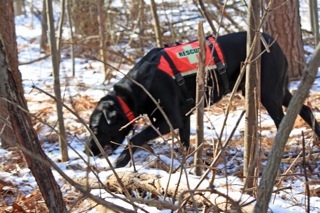|
K9 Air Scent Training For Search and Rescue
Training your K9 to find a missing person by following their nose, isn't that hard. It's natural for a dog to follow a smell until it finds the origin. As you teach your dog to follow his nose, you'll be learning his body language. You'll be surprised how easily your K9 picks up the game. It's actually harder for the handler to learn to "read" the dog, than it is to teach him how to play the game.
I always have people ask me "What types of dogs are the best for Search and Rescue"? There really isn't one correct answer for that. You want a dog that has high drive. You know, the kind that will chase the ball until your arm falls off, and then will chase some more. You want a dog that is friendly and sociable with other dogs, and people. Labs, and German Shepherds are the most popular, but mixed breeds are fine too. Even the smaller guys do well because they can search areas that some larger breeds can't get in to. It really is your discretion. The first step in training your Air Scent K9 is to do what's called a "runaway". A runaway is simply a tease factor in getting your dog's attention focused on following a toy to get the reward. See! I told you it was playtime!
You will have your dog on leash, while another person takes his favorite toy and teases him while running away in a straight line… and into the wind. The purpose of this is to get the dog to want the toy bad enough that he follows straight to the other person and receives a reward…(treat or toy). Let your dog off the leash and give him the command to "go find". He should run straight over to get his toy. Reward him with his toy, or a treat and lots of praise! Do this a couple times each day, moving farther and farther away.
As he catches on, have the other person hide nearby, always, into the wind, so he can pick up the scent easier. Watch as he begins to use his nose to find the person, because he won't be able to see them. Make it easy at first. It may take a few tries before he catches on. Keep rewarding and praising. As he gets better, hide in more difficult areas. The indication is what the K9 will do to "tell" you he's found someone. Some dogs sit and bark, some will grab a pull toy or something the handler carries with them. Some dogs like mine would not do a particular indication, no matter how hard I tried. I had to learn his body language when he came back to me. He was excited, and would jump up on me to get my attention. You have to do what works for your dog. No K9 will work exactly the same as another. To add the refind after he finds the person, stand far enough away to call him back. When he comes back, reward him, then give him a different command, like "show me". You may have to help him back to the person, because he may not understand what you're asking him to do. When you return to the person, praise and reward him. Sometimes it helps to have the subject hiding give a treat once the refind is done. I find that having a special toy for a reward, that he ONLY plays with at training is a good approach.
Return from "K9 AirScent" to "Training Your Search and Rescue K9"
|


